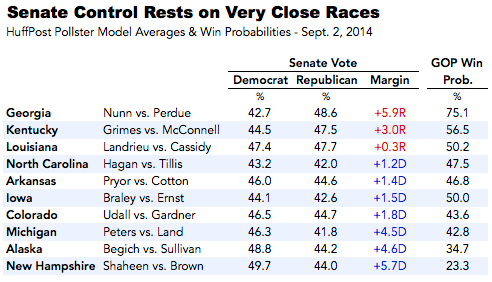
WASHINGTON -- The race for control of the U.S. Senate remains very much in doubt, coming down to a coin flip based on current voter preferences as measured by the latest public polls.
According to a new election forecasting model compiled by HuffPost Pollster and launched on Tuesday, Republicans have a 48 percent chance of taking control of the Senate. The outcome hinges on a handful of races where the poll-tracking model shows the Democratic and Republican candidates separated by less than 2 percentage points: Arkansas, Colorado, Iowa, Louisiana and North Carolina. In hotly contested races in four more states -- Alaska, Georgia, Kentucky and Michigan -- the leaders enjoy slightly greater margins, but either candidate still has a real chance of winning.

The HuffPost Pollster forecast is slightly more optimistic about the Democrats' chances than some other prominent news media forecasts, most notably those produced by The New York Times, The Washington Post and FiveThirtyEight, which calculate the probability of Republicans retaking the Senate at between 52 and 66 percent. The difference is that these models also incorporate other factors that have been historically predictive of election outcomes, such as candidate fundraising and measures of the national political environment, which are less favorable for the Democrats in 2014 than the current polling snapshot.
The modest differences between the models implies that polling snapshots in some of the contested races may yet grow more favorable to the Republicans as the campaign progresses, either because some voters will gravitate toward GOP candidates as they grow more engaged in the election or because pollsters have not yet adequately accounted for the turnout advantage that Republicans usually enjoy in off-year elections.
Either way, the differences between these forecasting models are slight. "Fundamentally," as Princeton neuroscientist and election forecaster Sam Wang puts it, "any probability in the 40-60% range is a numerical way of saying 'I don’t know.'"
Similarly, Amanda Cox, New York Times graphics editor and co-creator of the Upshot election model, commented Saturday about the way many seem to perceive 60 percent as a lopsided forecast.
"I think it is very easy to interpret that as something that is not a coin flip," Cox explained at a panel convened at the annual meeting of the American Political Science Association. She noted an attempt to explain the difference between flipping hypothetical coins, one of which comes up heads 50 percent of the time, and the second of which comes up heads 60 percent of the time. "You'd have to flip for a half hour before you knew which one was which," she said. "That’s a lot of coin flips, but it’s still a coin flip."
A new feature of the HuffPost Senate Forecast allows readers to move "sliders" to try out different win probabilities for the most competitive seats, and it illustrates the tenuous nature of the overall chance each party will control the Senate. If just one of the closest races shifts from a near 50-50 coin flip to 90 percent certainty that a Republican win, the overall probability of Republicans winning control of the Senate would move to 57 percent. If two races were to shift in that direction, the probability would move to 67 percent.
According to the model, the most likely seat count as of this writing is 50 Democrats and 50 Republicans, with Vice President Joe Biden breaking the tie to keep the Democratic majority. This includes the 64 seats not up for election: 30 held by Republicans and 34 by Democrats. The GOP needs to win 21 seats to take the majority, and have an 85 percent or greater probability of winning 16 seats. The data give the Republicans a 75 percent chance of winning in Georgia, which means they need to win exactly half -- four of eight -- tossup seats in order to take the majority.
HOW THE MODEL WORKS
HuffPost Pollster begins by collecting every publicly released poll on the 2014 Senate races. We then use a statistical model to estimate the trend in support for each candidate based on all the survey data, adjusting for sample size and pollsters’ “house effects.” Interactive charts of those support trends are available on the HuffPost Pollster home page.
HuffPost's model offers advantages over some others, however, in terms of understanding how the polls work. As explained in more detail previously, we do not treat polls equally; instead, the model considers the true poll average to be that of nonpartisan polls with a record of performing well.
By running a series of simulations (known commonly as the Monte Carlo method), the model allows us to quantify the uncertainty associated with the current polling snapshot. That uncertainty comes from multiple sources: sampling error in the polls themselves, uncertainty about the house effect corrections, and uncertainty about how quickly vote intentions are changing.
The model then calculates a “win probability” for each race that takes three factors into account:
- The time remaining between the current snapshot and the election.
- The possibility that the polls could be wrong or that some sort of major event could shake up a race in ways that the current polls can’t measure.
- The proportion of “undecided” voters in the polls. If the undecided proportion is high relative to the expected margin between the candidates, the outcome of that race must be less certain.
Once the final probabilities for each state are calculated, we perform another set of Monte Carlo simulations to calculate the probability of Republicans winning 51 or more seats in the Senate.
Yet for all the precision implied by this statistical terminology, it's important to remember the role of uncertainty. In some of the most competitive Senate races, the projected winner has barely better than a 50-50 chance of winning. In those cases, the probabilities also mean our model has a near 50 percent chance of being wrong about which candidate will win. As of right now, we’re predicting some very close races, and the Senate balance remains on a razor’s edge.

